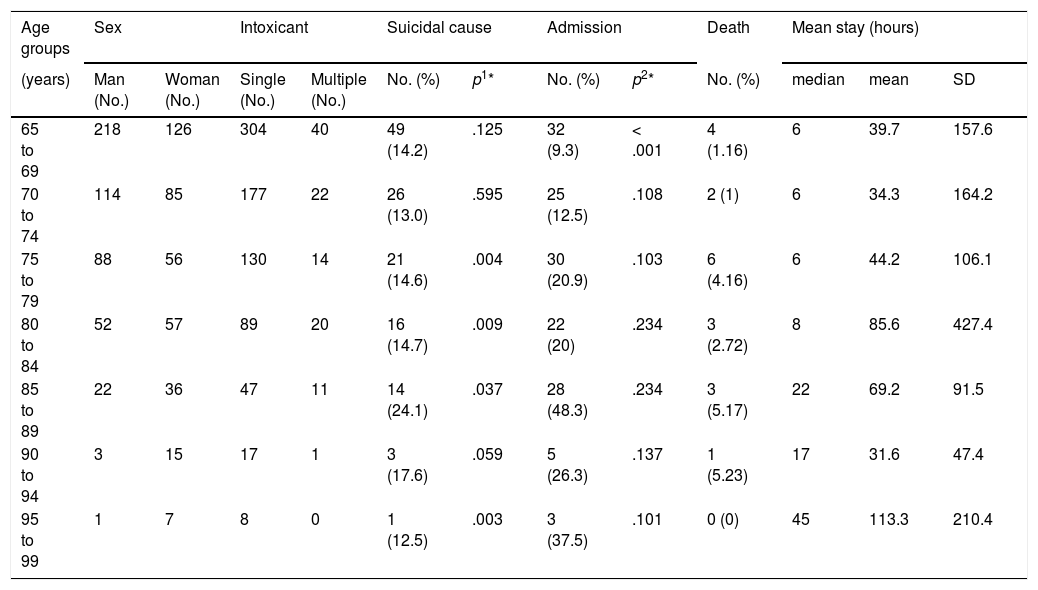Poisonings continue to be an important public health problem. Herein, we analyzed the epidemiology of poisonings in elderly individuals.
MethodsRetrospective cohort study conducted between 2011 and 2019 in a university hospital. We analyzed demographic variables, type of poison involved, suicidal or accidental nature of the poisoning, and the probability of admission, or death to the hospital.
ResultsA total of 880 (6.1%) of the 14,300 poisonings treated in the same period occurred in people over 65 years of age. The most numerous group were individuals between 65–69 years-old (39%), followed by the group of 70–75 years-old (20%), being men 57%. In 88% of the cases a single poison participated, being by frequency alcohol (51.6%), drugs (29.5%), and household or industrial products (12.8%). Alcohol intoxication predominated in men up to 75 years of age, and above this age drug or suicidal intoxication predominated, mainly in women. A total of 145 (16%) subjects were hospitalized, the drugs most frequently implicated being digoxin and benzodiazepines. The probability of hospital admission was associated with intoxication by metformin, digoxin, lithium or with the age of the patient (OR per year = 1.03; 95% CI: 1.0–1.06). A total of 19 patients died (2.16%), mainly due to suicidal caustic ingestion (OR = 5.7: 95% CI: 1.4–23.6) or by drugs, directly related to metformin (OR = 10.1; 95% CI: 2.4–42.4).
ConclusionsThe prevalence of poisoning in the elderly is not negligible, and physicians should have a high index of suspicion in a complex situation.
Las intoxicaciones siguen siendo un problema de salud pública importante. En el presente estudio evaluamos la epidemiología de las intoxicaciones en la tercera edad.
MétodosEstudio de cohorte retrospectivo realizado entre 2011 y 2019 en un hospital universitario. Analizamos variables demográficas, tipo de tóxico involucrado, naturaleza suicida o accidental de la intoxicación y la probabilidad de ingreso o muerte en el hospital.
ResultadosUn total de 880 (6,1%) de las 14.300 intoxicaciones atendidas en el mismo período sucedieron en mayores de 65 años. El grupo más numeroso fueron individuos entre 65-69 años (39%), seguidos por el grupo de 70-75 años (20%), siendo varones el 57%. En el 88% de los casos participó un único tóxico, por orden de frecuencia alcohol (51,6%), fármacos (29,5%) y productos domésticos o industriales (12,8%). Las intoxicaciones por alcohol predominaron en hombres hasta los 75 años y por encima de esta edad predominó la intoxicación farmacológica o suicida, principalmente en mujeres. Ingresaron un total de 145 (16%) sujetos, siendo los fármacos más frecuentemente implicados digoxina y benzodiacepinas. La probabilidad de ingreso se asoció con la intoxicación por metformina, digoxina, litio o la edad del paciente (OR por año = 1,03; IC 95%: 1,0-1,06). Fallecieron 19 pacientes (2,16%), principalmente por ingestas cáusticas suicidas (OR = 5,7: IC 95%: 1,4-23,6) o por fármacos, relacionados directamente con la metformina (OR = 10,1; IC 95%: 2,4-42,4).
ConclusionesLa prevalencia de intoxicaciones en la tercera edad no es despreciable, y los médicos deben sospecharlas ante situaciones clínicas complejas.
Article
Diríjase desde aquí a la web de la >>>FESEMI<<< e inicie sesión mediante el formulario que se encuentra en la barra superior, pulsando sobre el candado.

Una vez autentificado, en la misma web de FESEMI, en el menú superior, elija la opción deseada.

>>>FESEMI<<<











